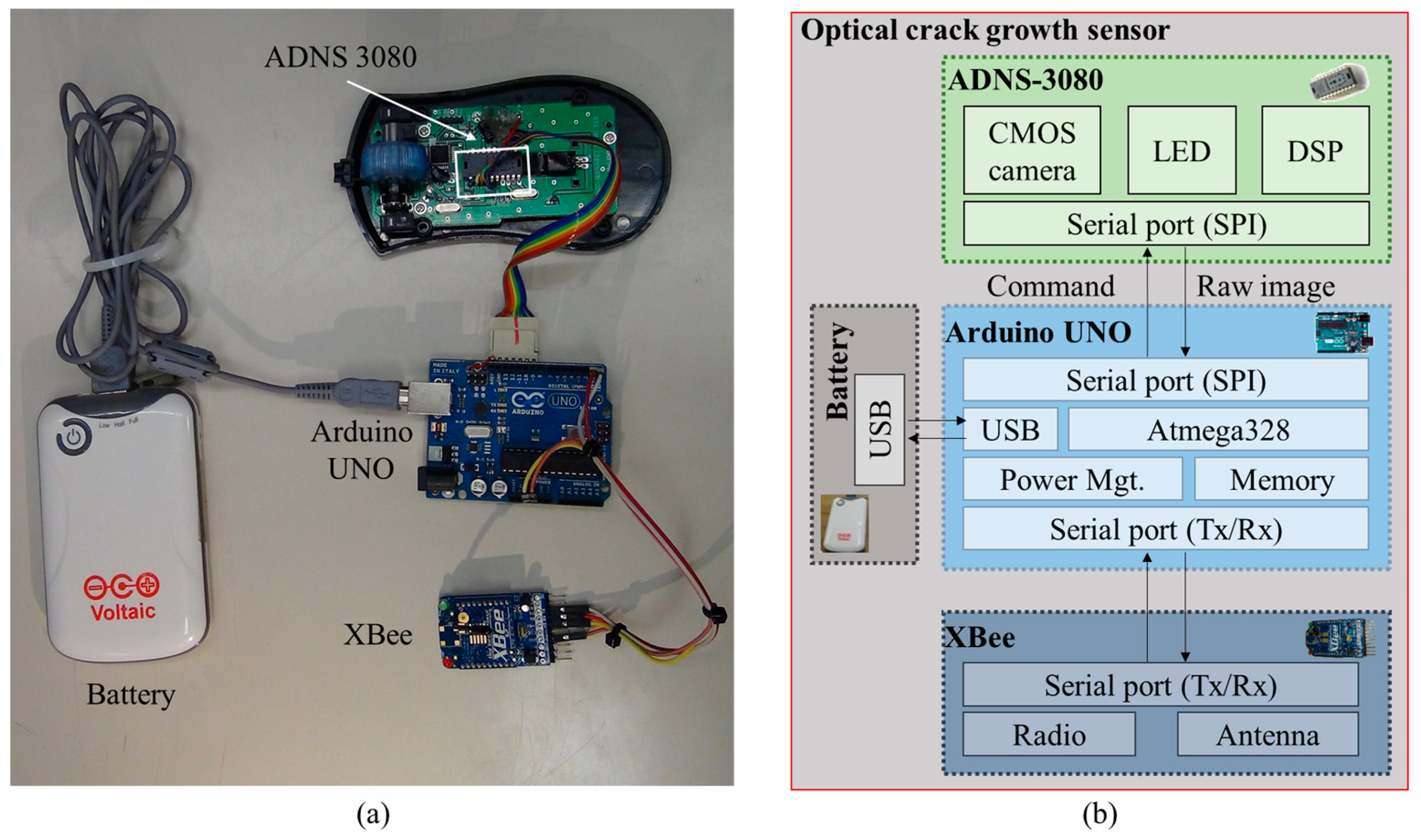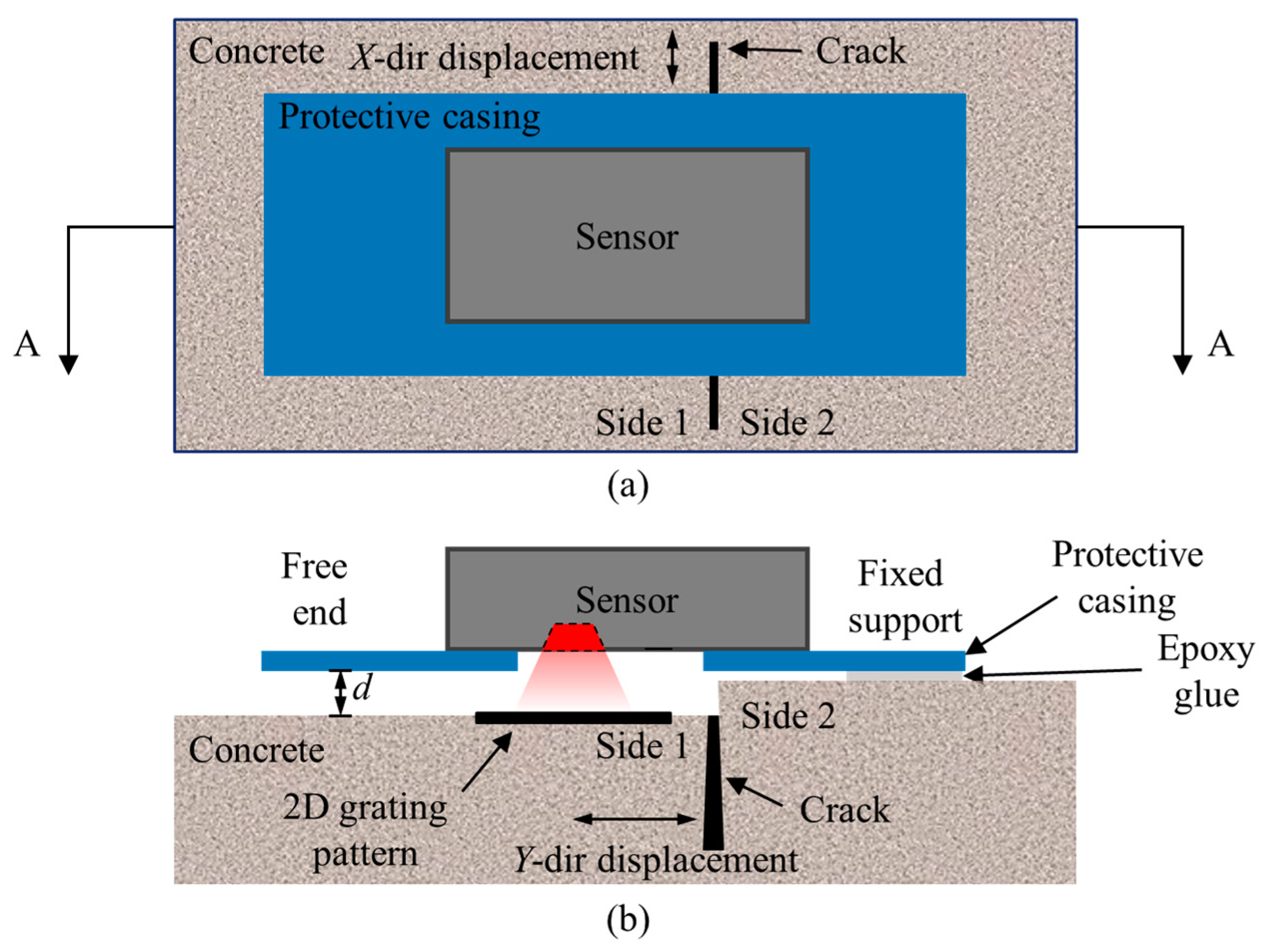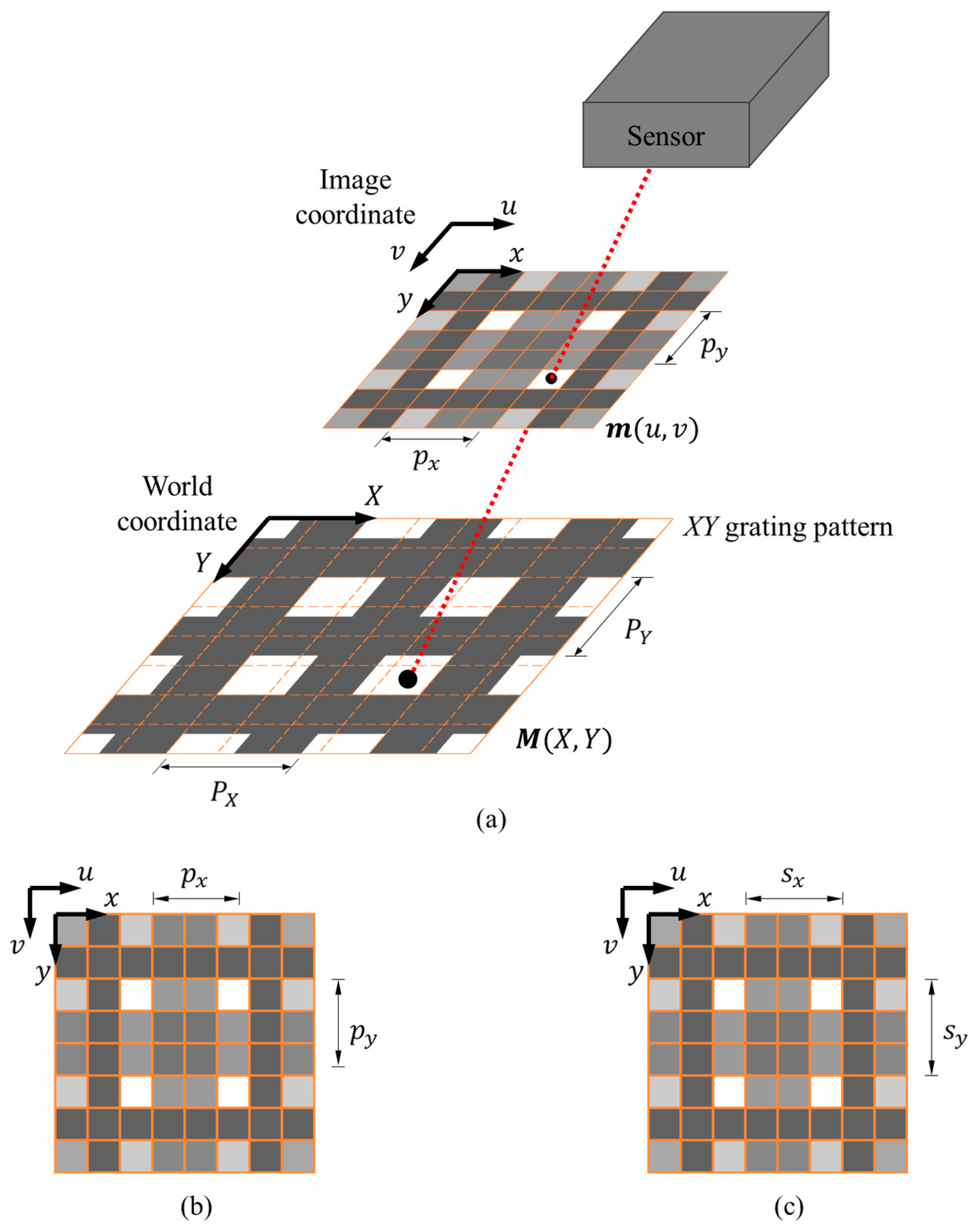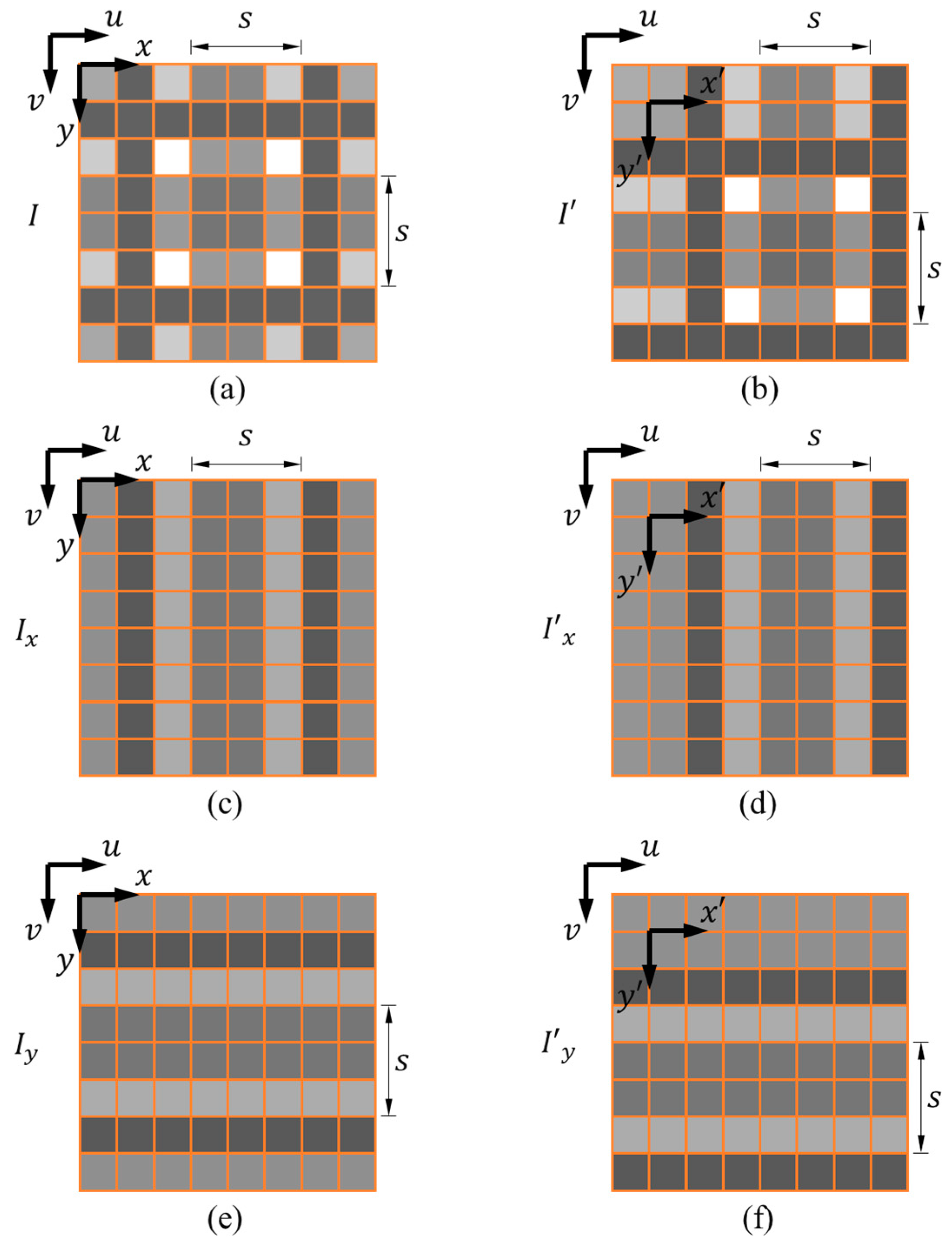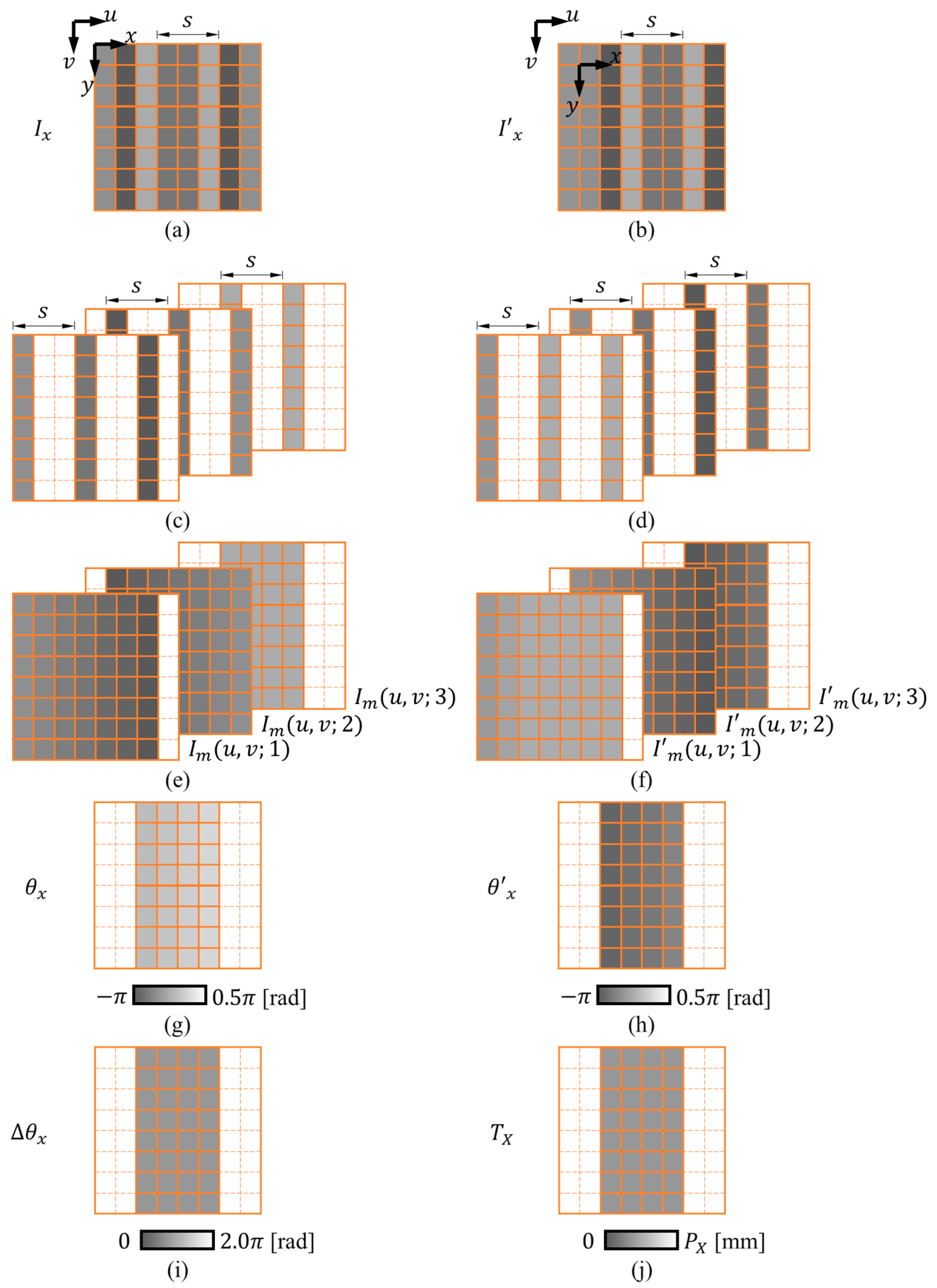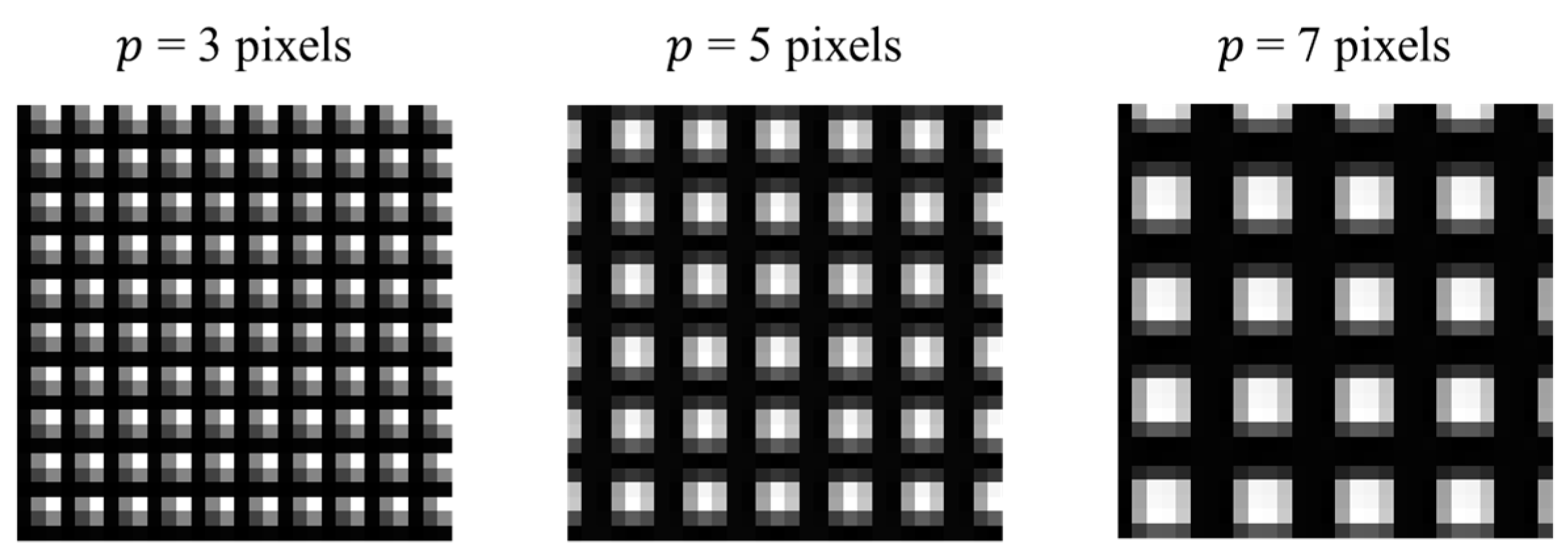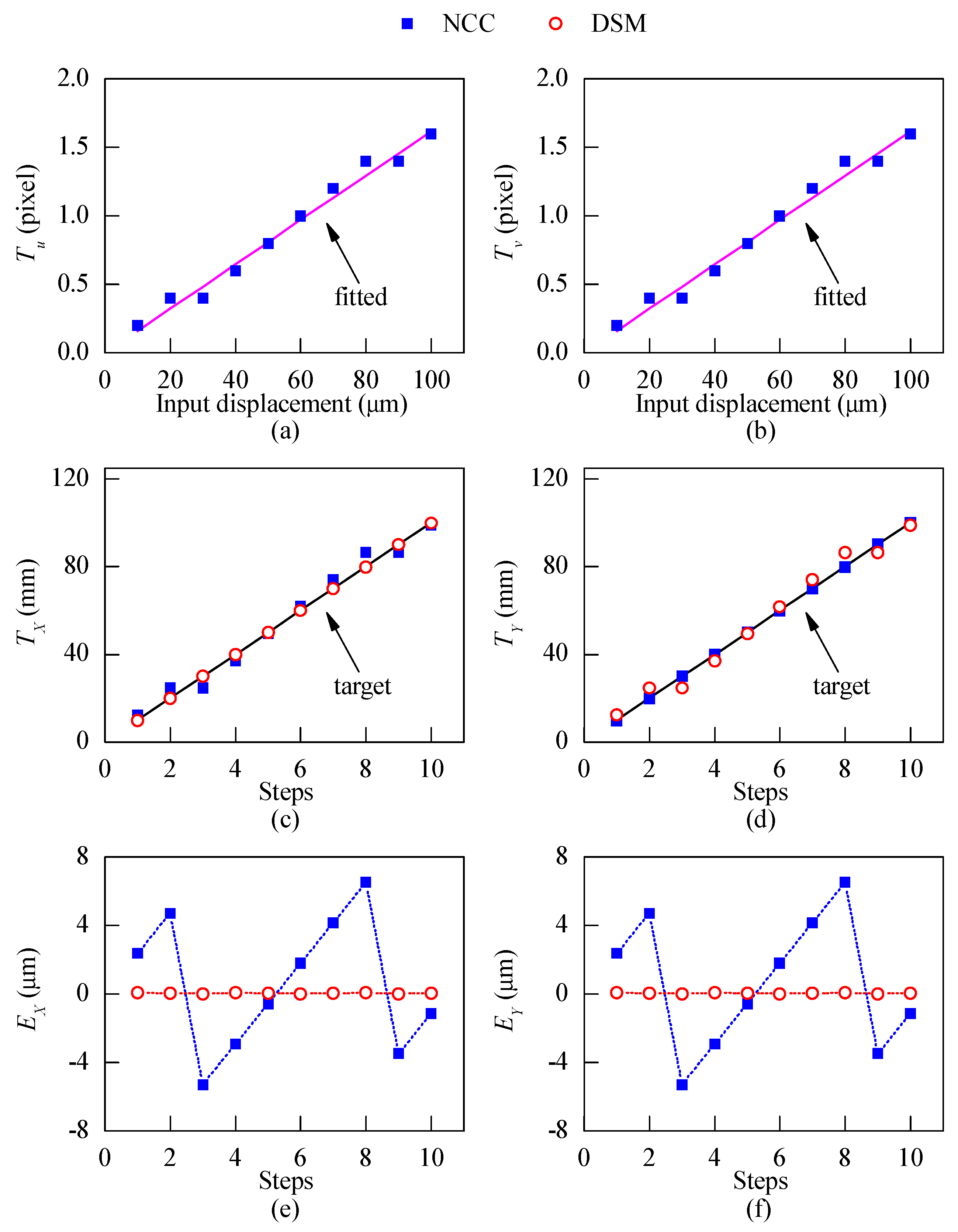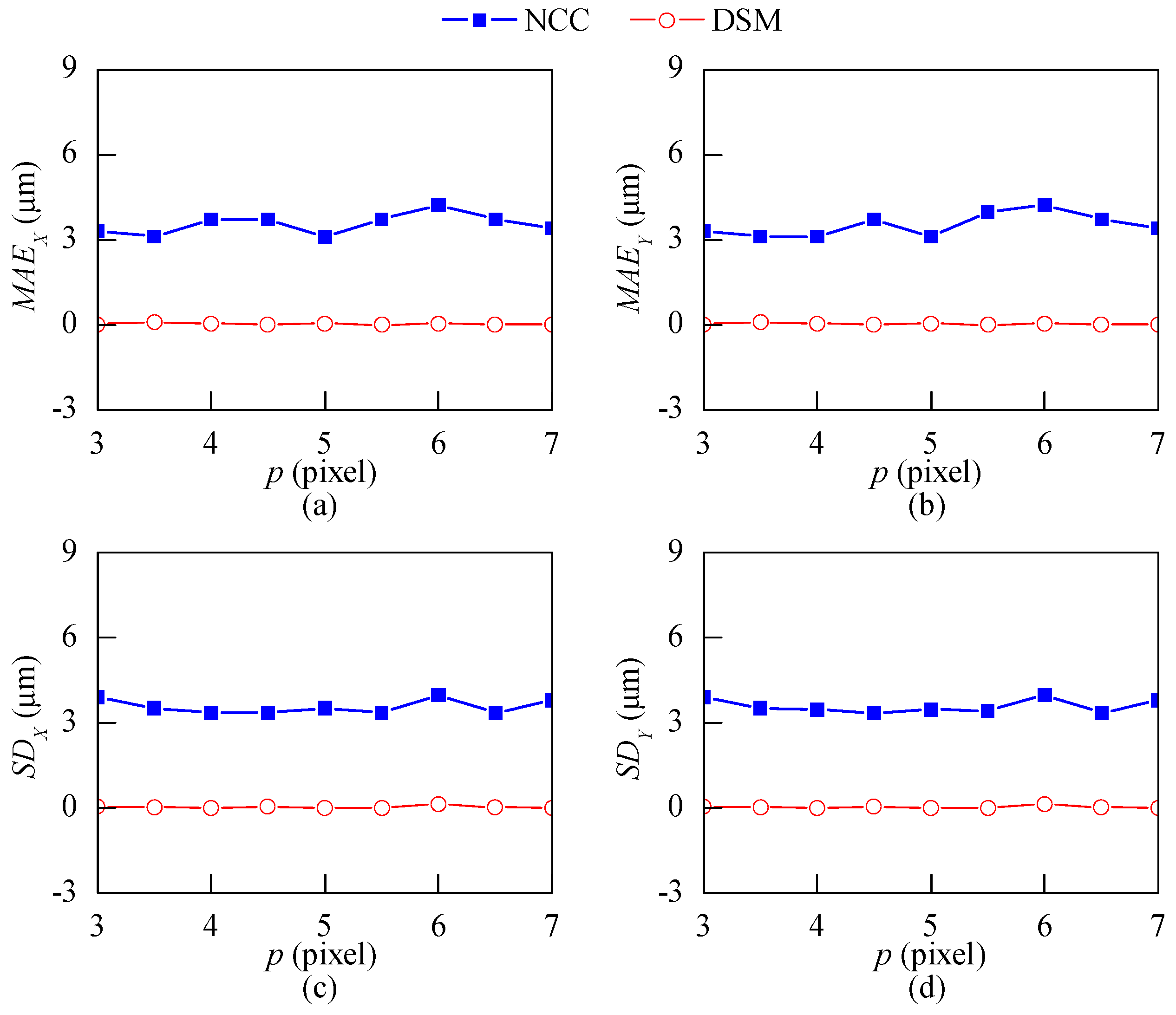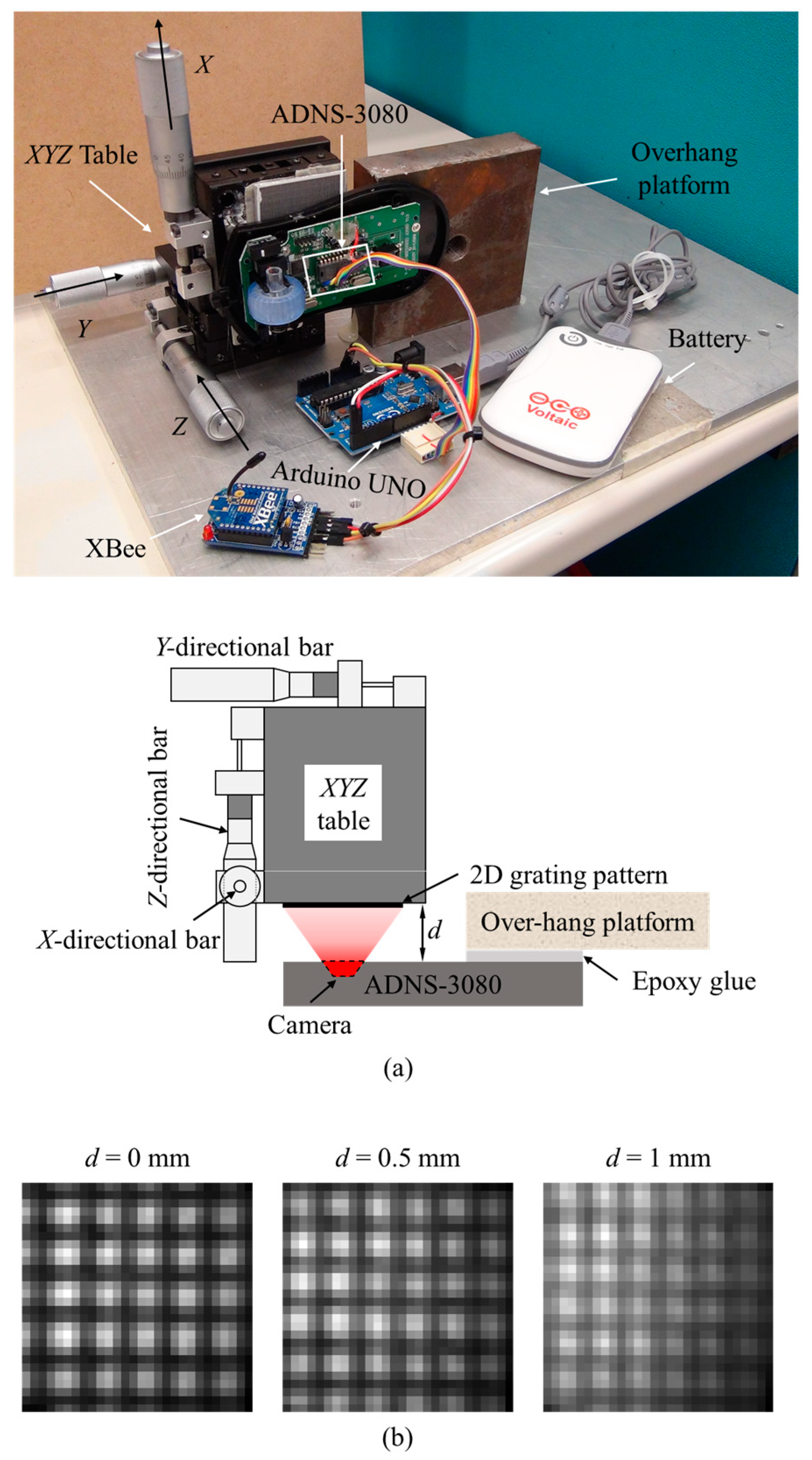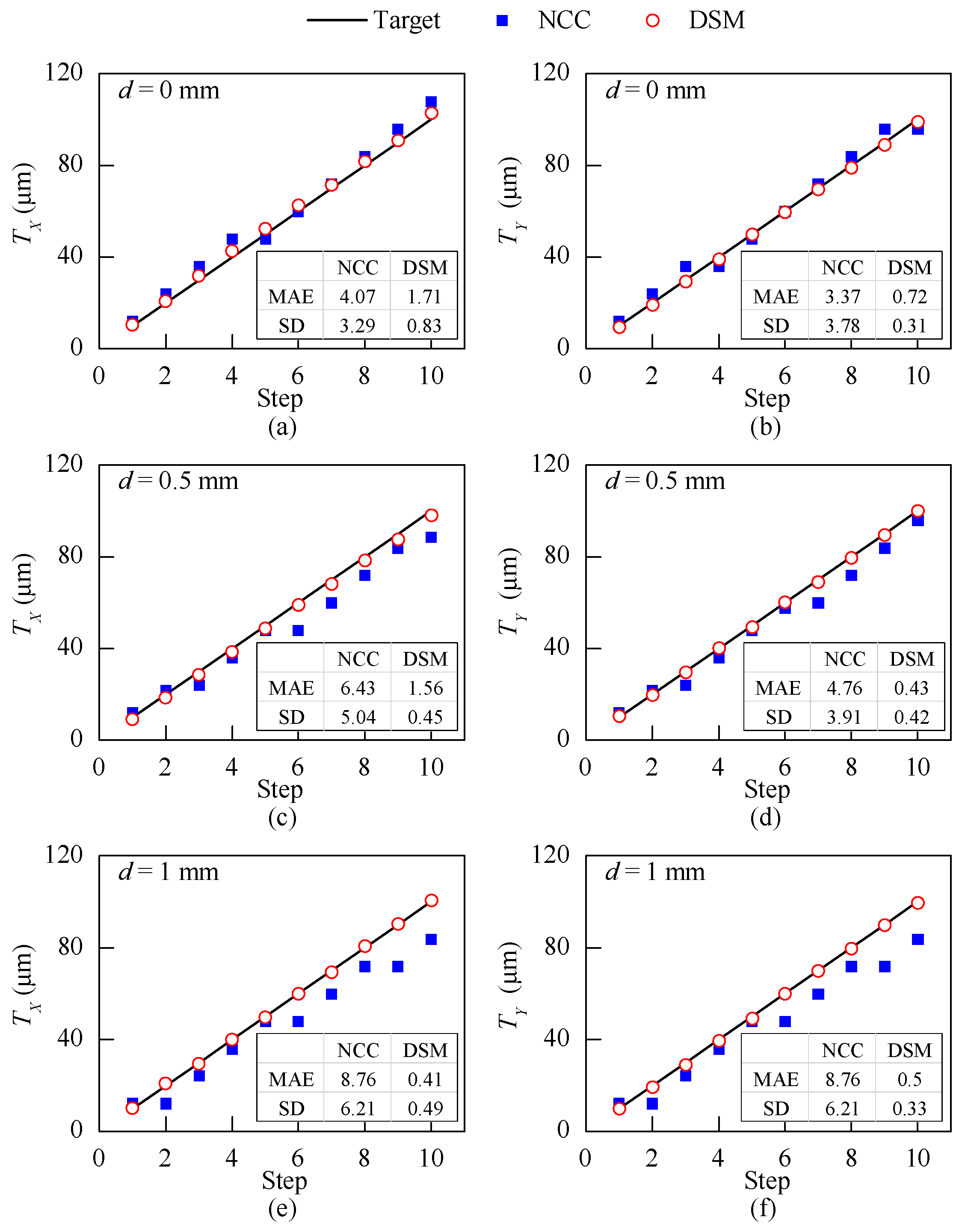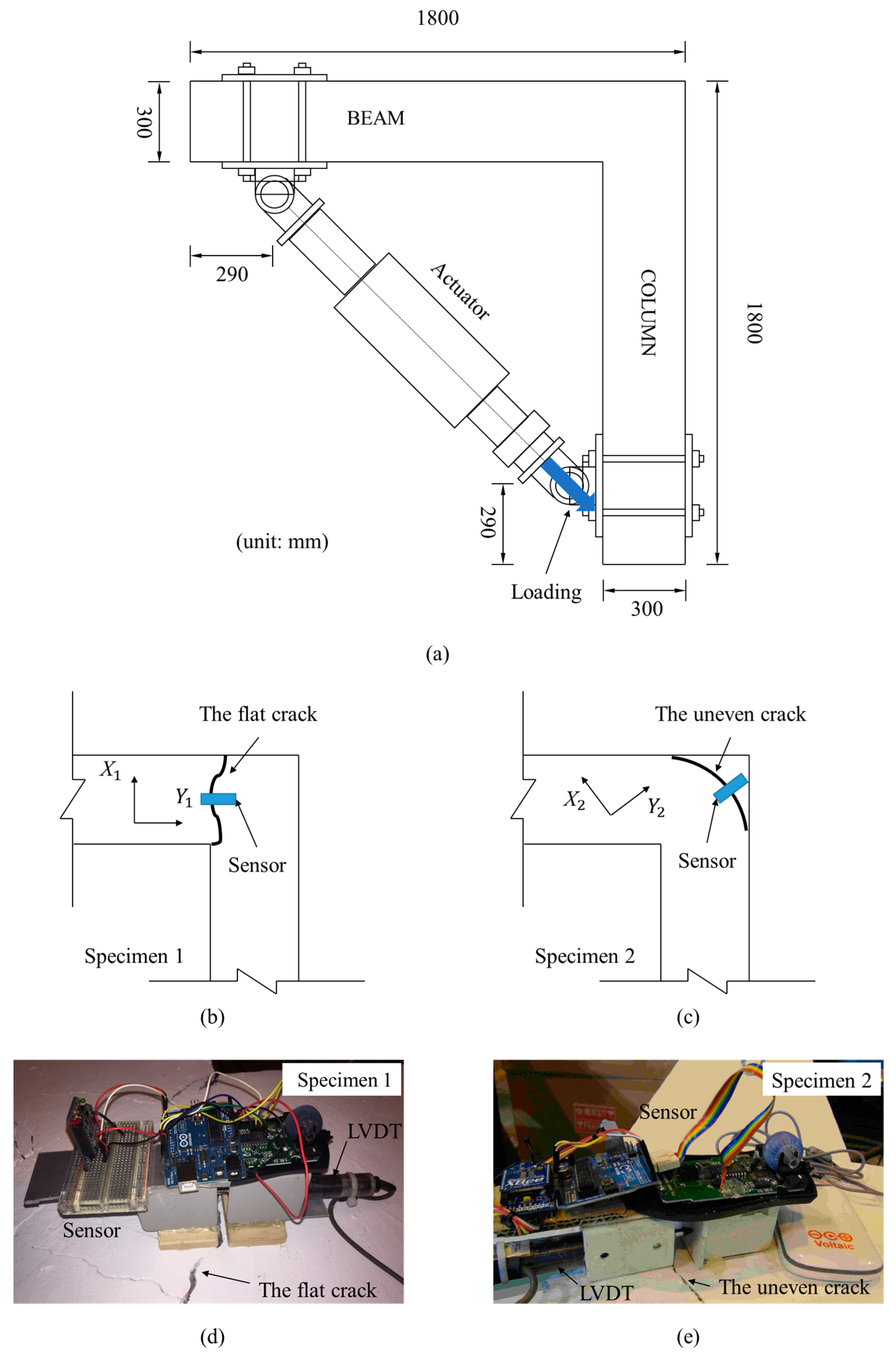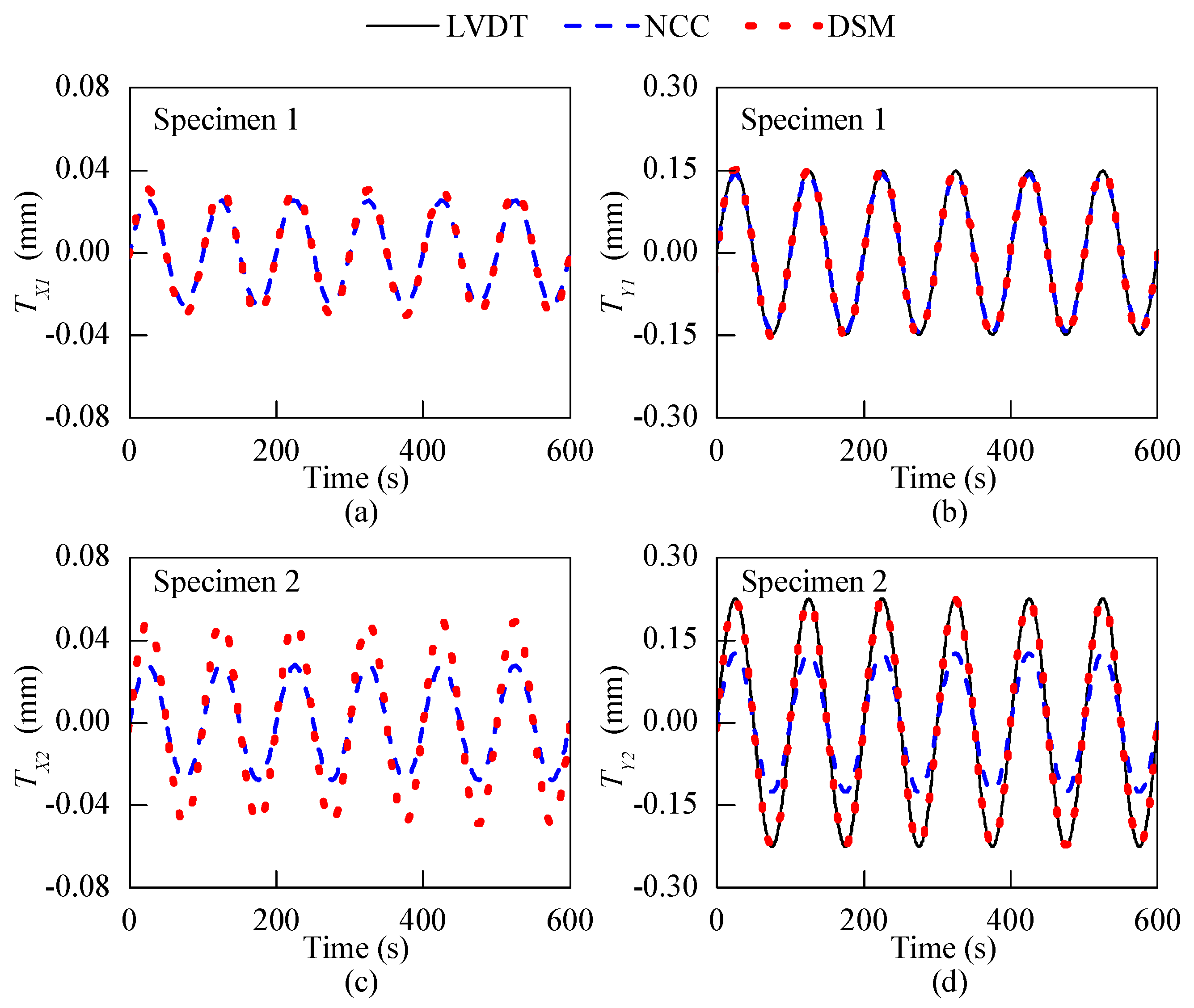1. Introduction
Concrete deterioration is usually initiated with the appearance of surface cracks. Excessive crack propagation may result in possible dysfunction or even failure of concrete structures [
1]. Therefore, crack growth monitoring is of great significance in the risk assessment of a variety of constructed facilities [
2]. Currently, a wide range of sensors have been developed to quantitatively measure the crack growth for structural health monitoring purposes. For instance, an optical fiber sensor was imbedded into the structural components to detect and track the opening of a crack on a real bridge [
3]. Mao et al. proposed a method for corrosion process monitoring by combining the fiber Bragg grating and Brillouin optical time domain analysis [
4]. Li et al. integrated the acoustic emission technique and fiber optic sensing for concrete deterioration tracking [
5]. The strain gauges and the linear variable differential transformer (LVDT) were applied to measure the change in the crack width of a concrete specimen in the splitting tension test [
6]. The eddy current sensor and the string potentiometer were attached on an adobe house to track the crack extension induced by the vibratory compassion excitation and climatological effects at micro-meter level [
7]. These sensors are either imbedded into the structures or mounted on the structural surface, and they are cabled sensors that need to be connected with wires for data transmission. However, cable installation and maintenance are expensive and time-consuming, and the installation of cabled sensors would influence the normal operations of the facilities [
8,
9].
In contrast, the wireless crack growth sensors transmit data without cables and they have been applied for crack width monitoring on various civil structures: Bennett et al. deployed the wireless sensors with 12 μm resolution for long-term crack monitoring in the Prague Metro and the London Underground [
10]; Hoult et al. applied the wireless sensors with a resolution of 10 μm for long-term crack monitoring on bridges [
8]; Zhou et al. used a high-accuracy wireless sensors with 1 μm resolution to monitor the dynamic crack width on an in-service reactor containment building during an every-ten years pressure test [
9]; Hughi and Marzouk investigated the performance of low-cost piezo-ceramic sensors for crack monitoring [
11]; Caizzone and DiGiampaolo developed a passive radio frequency identification (RFID) crack width sensor with submillimeter resolution based on electromagnetic coupling [
12].
One problem of these sensors is that they can only measure displacements along the alignment direction of the sensors, while cracks may propagate in multiple directions. Therefore, it is necessary to develop a wireless sensor that can measure two-dimensional (2D) crack growth. Zhang et al. proposed a smart film crack sensor for monitoring the cracks’ location, shape, and propagation [
13]. The smart film was composed of enameled wires, and the crack monitoring was based on the proportional relationship between the crack width and ultimate strain of the broken wire. The image processing technique is another full-field method that can track multi-directional crack propagation. Shan et al. presented a stereovision-based method for crack width measurement [
14]. Two cameras were used to track the 3D coordinates of two crack edges, and the minimum distance between two edges is regarded as the crack width. Another image processing method, the digital image correlation method, has been applied to assess cracks on fiber concrete beams [
15], where a single camera was required that must be aligned well to ensure that the image plane is parallel with the interested region. A “stick and detect” crack growth sensor using the normalized cross-correlation (NCC) method as the image processing algorithm was developed for 2D crack monitoring [
16]. This crack growth sensor was glued on one side of the crack and took images of the pattern attached on the other side of the crack. The height difference between the two sides of the crack is the main factor that influences the imaging distance, which is the distance between the sensor and the target. The NCC algorithm tracks the displacement of multiple points in a series of images according to their light intensity distribution [
17]. Since the obtained displacement is in the image domain with the unit of pixels, a scale factor (pixel/mm) relating the physical domain and the image domain should be calibrated to calculate the displacement in the physical domain. One challenge is that the scale factor is sensitive to the imaging distance, which is the distance between the sensor and the target [
18]. The imaging distances are not constant for all cracks due to their variant height differences between the two sides. Therefore, the scale factor obtained through the calibration process with a fixed imaging distance cannot be ubiquitously applied on uneven cracks with different imaging distances and heights. The mismatch of the scale factor between calibration and application may lead to measurement errors and affect the accuracy of the NCC method [
18].
The moiré technique has been adopted for displacement measurement for a long time [
19]. Traditionally, the geometric moiré method generates moiré fringes through the overlapping of two regular gratings [
20]. The generated moiré fringes can amplify the grating’s motion, so a displacement measurement with a high accuracy can be obtained [
19]. A scanning moiré method was proposed to generate moiré fringes by sampling a grating pattern using a scanner composed by a set of regularly spaced dots or lines [
21]. However, the sensitivity of the geometric and scanning moiré methods are limited as they only use the information of the moiré fringes’ centerlines [
22,
23]. To achieve higher sensitivity, a temporal phase shifting method which makes use of the whole intensity profiles of the grating was developed [
24,
25,
26]. A series of moiré fringes were produced by moving the grating with a transducer, and then the obtained moiré fringes were used to compute the phase distribution of the grating. At least three moved moiré fringes are required for the phase calculation of one single grating, therefore this method is not suitable for dynamic analysis. Recently, a digital sampling moiré (DSM) method was developed for high-sensitivity and dynamic displacement measurements [
22]. In this method, a series of phase-shifted moiré fringes was generated from one image of the captured grating pattern through down-sampling and up-sampling. The discrete Fourier transform was then used to calculate the phase distribution of the recorded grating. In the final step, the phase difference between the two recorded gratings was used to compute the relative displacement. Results showed that the accuracy of the DSM method could approach 3.8 µm in a three-point bending test of a steel beam, which was equivalent to a 0.01 pixel in the image domain [
22]. Comparing this with the NCC method adopted in the wireless crack sensor, one advantage of the DSM method is that the obtained results are in the phase domain, and the corresponding physical displacements can be calculated easily using the predefined pitch length. As a result, the moiré technique does not require any prior calibration to compute the scale factor which relates the image domain with the physical domain, and this technique is robust to the imaging distance since the predefined pitch length is not affected by the imaging distance.
In this study, an optical crack growth monitoring sensor incorporating the DSM algorithm is developed. This sensor is composed of an optical navigation sensor board (ADNS-3080, Avago technologies, San Jose, CA, USA), a processor (Arduino UNO), a wireless platform (XBee), and a battery. The crack displacements are computed based on a series of images taken by the ADNS-3080. The captured images are processed by the Arduino UNO using the DSM method to calculate the 2D translations of cracks. In the following sections, the development of this sensor is presented, and its performance is tested by the numerical simulation and laboratory tests.
2. Prototype and Hardware Components
Figure 1a shows a prototype of the optical crack growth sensor, it is composed of four parts: Arduino UNO, ADNS-3080, XBee, and battery. The Arduino UNO is a microprocessor that contains 32 kilobytes (KB) flash memory and 2 KB static random-access memory (SRAM) [
27]. The Arduino UNO contains several types of interfaces such as an inter-integrated circuit bus (I2C), a Serial Peripheral Interface Bus (SPI), and a Tx/Rx serial port. The variety of interfaces makes the Arduino UNO adaptable and able to connect with different types of sensors and devices. ADNS-3080 is an optical sensor with a complementary metal-oxide-semiconductor (CMOS) camera which acquires images of the underneath surface illuminated by the embedded light-emitting diode (LED) [
28]. It also includes a digital signal processor (DSP) and a serial port. XBee is a wireless communication board with a receiver’s sensitivity as high as −92 dBm [
29]. According to the IEEE802.15.4 standard, XBee has a longer communication range than Bluetooth and requires less power [
30]. As shown in
Figure 1b, the ADNS-3080 and the XBee interface with the Arduino UNO through the Tx/Rx serial port and the SPI port, respectively. The battery can provide power through Universal Serial Bus (USB).
For crack growth monitoring, the ADNS-3080 receives the command from the Arduino UNO to capture images. The captured images are then sent to the Arduino UNO and are processed with the DSM algorithm to calculate 2D displacements. After the calculation, the results are transmitted wirelessly through the XBee to a computer for further analysis. Similar to other crack growth sensors for long-term crack monitoring [
8,
9,
10], this crack growth sensor should be mounted across the crack. As shown in
Figure 2, the grating pattern was attached on side 1 of the crack, and it was recorded by the developed sensor fixed on side 2 of the crack. The crack’s growth was measured by detecting the relative motion between the fixed support and the 2D grating pattern. In
Figure 2b,
d is the imaging distance between the sensor and the target pattern. Since the thickness of the epoxy glue used to fix the sensor is ignorable,
d is mainly determined by the height difference between the two sides of the crack.
3. The Digital Sampling Moiré (DSM) Method
The principle of the DSM method [
22] is briefly summarized here. As shown in
Figure 3, a 2D grating pattern with
X- and
Y-directional gratings is used to generate moiré fringes. The
XY coordinates are attached on the 2D grating pattern, and their projection on the image plane in the
uv image coordinates are represented as the
xy coordinates. The physical lengths of one cycle of the corresponding grating (one white and one black bar) along the
X and
Y directions are denoted as
and
, respectively, and their corresponding pitch lengths in the image domain are denoted as
and
, respectively. As shown in
Figure 3b,c, the nearest integer values of pitch lengths of
X- and
Y-directional gratings in the image plane are
and
, respectively. To simplify the following derivation,
and
are set to be identical as
P, and likewise
, and
=
.
The DSM method computes the relative 2D displacement using a reference image
I and a subsequent image
acquired between the motion of the grating pattern (see
Figure 4a,b). The first step is to extract the
x- and
y-directional gratings using
pixel and
pixel spatial average filters, respectively. The
x-directional grating
and
-directional gratings
filtered from
and
are shown in
Figure 4c,d, respectively. The
y-directional grating
and
-directional gratings
filtered from
and
are shown in
Figure 4e,f, respectively. The calculation process of
X-directional displacement
is demonstrated in
Figure 5. The extracted
x-directional grating
and
are shown in
Figure 5a,b, respectively. Express
as
where
is the amplitude of the grating intensity, and
represents the background intensity, and
is the phase distribution of the
x-directional grating.
The DSM method generates moiré fringes through down-sampling and interpolation.
Figure 5c,d illustrate the down-sampling of the gratings
and
, in which every
pixels (in this illustration,
= 3 pixels) are chosen starting from the 1st, 2nd, and 3rd pixels to obtain a series of down-sampled gratings, respectively. Next, interpolation is performed to generate the corresponding moiré fringes shown in
Figure 5e,f. The following equation presents the
k-th moiré fringe
where
is the phase distribution of the first moiré fringe, as shown in
Figure 5g. Using the discrete Fourier transform, its value can be calculated as,
Following the same procedure, the phase distribution of the moiré fringe after motion
can be obtained by utilizing the moiré fringes
(
Figure 5h). Next, the phase difference
(
Figure 5i) can be calculated from the following equation:
Finally, knowing the phase difference, the translation along
X-direction,
(
Figure 5j), can be calculated as follows
the translation along
Y-direction
can be obtained in the same way.
5. Discussion
In this work, a DSM-based optical crack growth sensor for the health assessment of concrete structures was developed by integrating Arduino UNO, XBee, and an optical navigation sensor board (ANDS-3080). Compared to the previous sensor which uses the NCC method as displacement measurement algorithm, this newly developed sensor adopts the DSM method and exhibits a few improvements. First, a calibration process is not required to get the accurate scale factor between the image domain and the physical domain; second, it can be applied on cracks with different d (the imaging distance between the target pattern and the sensor); third, a higher accuracy can be achieved with a lower computational cost.
Simulations and laboratory tests were performed to compare the NCC and DSM methods in multiple aspects. The simulation shows that the DSM method does not need calibration to obtain the scale factor of the imaging system, and it can achieve a higher sensitivity at a lower computational cost than the NCC method. The XYZ-table test demonstrates that the DSM-based sensor can achieve high-accuracy displacement measurements with MAE and SD smaller than 2 and 1 , respectively. Meanwhile, it also shows the robustness of the DSM method to the imaging distance d. The optical sensor was then used to track the 2D harmonic motion of two real cracks. The results show that the NCC method can measure accurate displacements only for the crack with a flat surface, of which the scale factor is consistent between calibration and the real test. On the other hand, the DSM-based sensor can detect precise crack motions for both flat and uneven cracks with different d values. The results exhibit the robustness of the proposed optical sensor to uneven cracks on real structures. These advantages make the DSM-based optical crack growth sensor a powerful tool for high-accuracy monitoring of 2D concrete crack growth.
While the experimental tests in this proof-of-concept study were performed in a laboratory under relatively stable temperature and humidity conditions, the proposed sensor exhibits some characteristics which might give it some edges for actual implementation. The operating temperature of the sensor’s main components (ADNS-3080, Arduino UNO, XBee, and battery) is in the range of 0–40 °C, which seems to meet the demand of most structures under normal environmental conditions. In addition, this sensor has an embedded camera and a built-in LED as light source. In application, the sensor is attached closely to the concrete surface and the lighting for image acquisition is solely supplied by the built-in LED. Its fixed mechanical structure creates a stable illumination and image acquisition condition that minimizes the influence of ambient light. However, the sensor’s components should be condensed, integrated, and weather-proofed before the sensor can be used for long-term monitoring under ambient conditions. Moreover, the temperature change would induce the deformation of the concrete and the grating pattern. To reduce the influence of this, the concrete deformation caused by thermal effects should be compensated for, and the grating pattern could be printed on a solid material such as a high-resistance magnet [
30].
